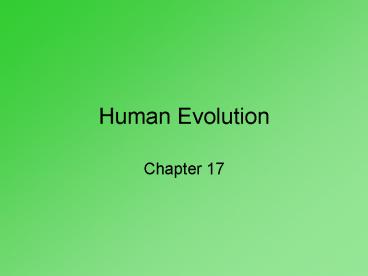Human Evolution - PowerPoint PPT Presentation
1 / 21
Title:
Human Evolution
Description:
Human Evolution Chapter 17 Primates Order primates includes prosimians, monkeys, apes, and humans Adapted for an arboreal life Human Evolution Humans and apes have a ... – PowerPoint PPT presentation
Number of Views:207
Avg rating:3.0/5.0
Title: Human Evolution
1
Human Evolution
- Chapter 17
2
Primates
- Order primates includes prosimians, monkeys,
apes, and humans - Adapted for an arboreal life
3
(No Transcript)
4
Human Evolution
- Humans and apes have a common ancestor
- Misconception Humans evolved from apes
- The human lineage and ape linage split around 6
million years ago - Humans and chimpanzees are the most closely
related - share around 99 of our DNA
5
Lemurs, lorises, and pottos
Ancestral primate
Tarsiers
New World monkeys
Monkeys
Old World monkeys
Anthropoids
Gibbons
Apes
Orangutans
Gorillas
Chimpanzees
Humans
Figure 17.36
6
Human Evolution
- All primates share one common mammalian ancestor
- Other primates diverged from the lineage
- Prosimians
- lemurs and tarsiers
- First primates to diverge
- Anthropoids
- New World monkeys, Old World monkeys, and
hominoids (apes and hominids)
7
Human Evolution
- Proconsul
- Probable link between monkeys and apes (about 15
mya) - About the size of a baboon
- Probably ancestral to dryopithecines
- All apes arose from about 10 mya
- Hominids can also trace their lineage to the
dryopithecines
8
Human Evolution
- Evolution of Hominids
- To be a hominid a fossil must have anatomy
suitable for standing and walking erect
(bipedalism) - Bipedalism made food gathering easier
- Believed that hominids appeared approximately 6
million years ago
9
0
?
Homo neanderthalensis
Paranthropus boisei
Homo sapiens
0.5
1.0
1.5
2.0
2.5
Homo erectus
Paranthropus robustus
3.0
Millions of years ago
Homo habilis
3.5
Australopithecus africanus
4.0
4.5
5.0
Australopithecus afarensis
5.5
Ardipithecus ramidus
6.0
Figure 17.38
10
Human Evolution
- Australopithecines
- Evolved in Africa 4 million years ago, went
extinct about 1 million years ago - Australopithecines had a small brain and walked
erect - No evidence of tool use
- Some were gracile (slender), others were robust
(powerful)
11
Australopithecus afarensis
12
Human Evolution
- Evolution of Early Homo
- Earliest fossils are about 2 million years old
- Larger brain than Australopithecines
- Jaws and teeth resemble humans
- Evidence of tool use
13
Human Evolution
- Evolution of Early Homo
- Homo habilis-
- Brain size as large as 772 cc enlarged speech
areas - Smaller cheek teeth indicates an omnivorous diet
- Findings indicate tool use
- Crude tools made of stone
- Culture
- Encompasses behavior and products
- Hunter and gatherers may have eaten together and
shared food
14
Human Evolution
- Evolution of Early Homo
- Homo ergaster and Homo erectus
- Fossils date between 1.9 and 0.3 million years
ago - Larger brain than H. hablis
- Stood erect, gait was similar to humans
- Evidence of migration from Africa to Asia
- Tools were advanced compared to compared to H.
hablis - First to use fire
- Systematic hunters
15
Homo ergaster
16
Human Evolution
- Evolution of Early Homo
- Homo floresiensis
- Evolved from Homo erectus
- Small in size compared to other hominids
- Likely co-existed with modern Homo sapiens
17
Human Evolution
- Evolution of Modern Humans
18
Human Evolution
- Neanderthals
- Lived between 200,000 and 28,000 years ago
- Massive brow ridges, protruding nose, jaws, and
teeth - Low, sloping foreheads
- Larger brain than H. sapiens, heavily muscled
- Culturally advanced
- According to the Out-of Africa hypothesis,
Neanderthals were displaced by modern humans
19
Neanderthals
20
Human Evolution
- Cro-Magnons
- Oldest fossils to be designated H. sapiens
sapiens - Modern appearance, made compound tools, were the
first to hunt with knives and spears - Hunted cooperatively
- May have been the first to have language
- Culture included art- sculpture and painting
21
Cro-Magnons































